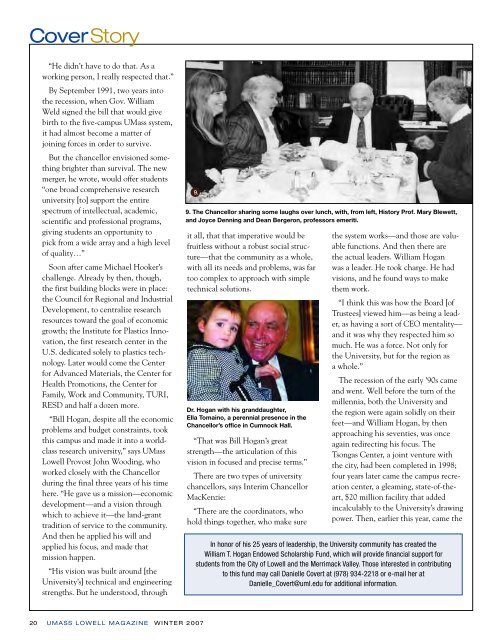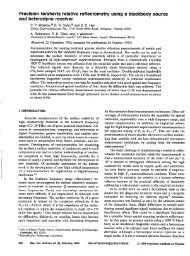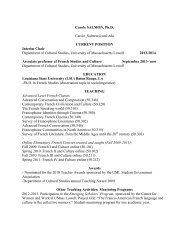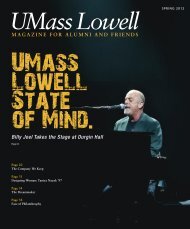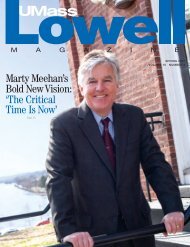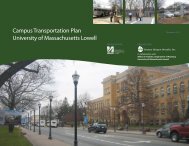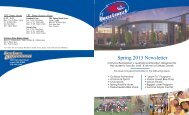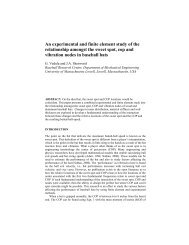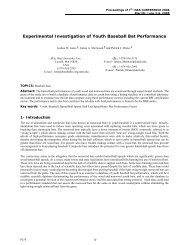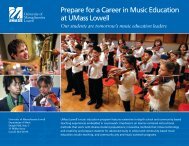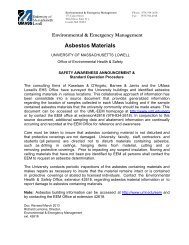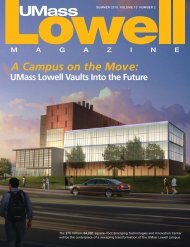THE HOGAN YEARS: - University of Massachusetts Lowell
THE HOGAN YEARS: - University of Massachusetts Lowell
THE HOGAN YEARS: - University of Massachusetts Lowell
You also want an ePaper? Increase the reach of your titles
YUMPU automatically turns print PDFs into web optimized ePapers that Google loves.
CoverStory<br />
“He didn’t have to do that. As a<br />
working person, I really respected that.”<br />
By September 1991, two years into<br />
the recession, when Gov. William<br />
Weld signed the bill that would give<br />
birth to the five-campus UMass system,<br />
it had almost become a matter <strong>of</strong><br />
joining forces in order to survive.<br />
But the chancellor envisioned something<br />
brighter than survival. The new<br />
merger, he wrote, would <strong>of</strong>fer students<br />
“one broad comprehensive research<br />
university [to] support the entire<br />
spectrum <strong>of</strong> intellectual, academic,<br />
scientific and pr<strong>of</strong>essional programs,<br />
giving students an opportunity to<br />
pick from a wide array and a high level<br />
<strong>of</strong> quality…”<br />
Soon after came Michael Hooker’s<br />
challenge. Already by then, though,<br />
the first building blocks were in place:<br />
the Council for Regional and Industrial<br />
Development, to centralize research<br />
resources toward the goal <strong>of</strong> economic<br />
growth; the Institute for Plastics Innovation,<br />
the first research center in the<br />
U.S. dedicated solely to plastics technology.<br />
Later would come the Center<br />
for Advanced Materials, the Center for<br />
Health Promotions, the Center for<br />
Family, Work and Community, TURI,<br />
RESD and half a dozen more.<br />
“Bill Hogan, despite all the economic<br />
problems and budget constraints, took<br />
this campus and made it into a worldclass<br />
research university,” says UMass<br />
<strong>Lowell</strong> Provost John Wooding, who<br />
worked closely with the Chancellor<br />
during the final three years <strong>of</strong> his time<br />
here. “He gave us a mission—economic<br />
development—and a vision through<br />
which to achieve it—the land-grant<br />
tradition <strong>of</strong> service to the community.<br />
And then he applied his will and<br />
applied his focus, and made that<br />
mission happen.<br />
“His vision was built around [the<br />
<strong>University</strong>’s] technical and engineering<br />
strengths. But he understood, through<br />
9.<br />
9. The Chancellor sharing some laughs over lunch, with, from left, History Pr<strong>of</strong>. Mary Blewett,<br />
and Joyce Denning and Dean Bergeron, pr<strong>of</strong>essors emeriti.<br />
it all, that that imperative would be<br />
fruitless without a robust social structure—that<br />
the community as a whole,<br />
with all its needs and problems, was far<br />
too complex to approach with simple<br />
technical solutions.<br />
Dr. Hogan with his granddaughter,<br />
Ella Tomaino, a perennial presence in the<br />
Chancellor’s <strong>of</strong>fice in Cumnock Hall.<br />
“That was Bill Hogan’s great<br />
strength—the articulation <strong>of</strong> this<br />
vision in focused and precise terms.”<br />
There are two types <strong>of</strong> university<br />
chancellors, says Interim Chancellor<br />
MacKenzie:<br />
“There are the coordinators, who<br />
hold things together, who make sure<br />
the system works—and those are valuable<br />
functions. And then there are<br />
the actual leaders. William Hogan<br />
was a leader. He took charge. He had<br />
visions, and he found ways to make<br />
them work.<br />
“I think this was how the Board [<strong>of</strong><br />
Trustees] viewed him—as being a leader,<br />
as having a sort <strong>of</strong> CEO mentality—<br />
and it was why they respected him so<br />
much. He was a force. Not only for<br />
the <strong>University</strong>, but for the region as<br />
a whole.”<br />
The recession <strong>of</strong> the early ’90s came<br />
and went. Well before the turn <strong>of</strong> the<br />
millennia, both the <strong>University</strong> and<br />
the region were again solidly on their<br />
feet—and William Hogan, by then<br />
approaching his seventies, was once<br />
again redirecting his focus. The<br />
Tsongas Center, a joint venture with<br />
the city, had been completed in 1998;<br />
four years later came the campus recreation<br />
center, a gleaming, state-<strong>of</strong>-theart,<br />
$20 million facility that added<br />
incalculably to the <strong>University</strong>’s drawing<br />
power. Then, earlier this year, came the<br />
In honor <strong>of</strong> his 25 years <strong>of</strong> leadership, the <strong>University</strong> community has created the<br />
William T. Hogan Endowed Scholarship Fund, which will provide financial support for<br />
students from the City <strong>of</strong> <strong>Lowell</strong> and the Merrimack Valley. Those interested in contributing<br />
to this fund may call Danielle Covert at (978) 934-2218 or e-mail her at<br />
Danielle_Covert@uml.edu for additional information.<br />
20 UMASS LOWELL MAGAZINE WINTER 2007


